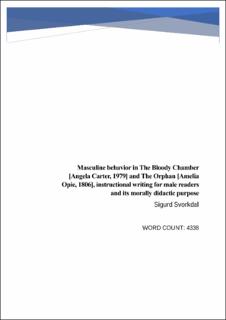| dc.description.abstract | As discussed in this paper, there could be argued that both The Orphan and The Bloody Chamber can serve a didactic and instructional purpose in form of a message based on morality and behavior. Both stories depict different characterizations of gender and behavior, and in different ways exemplifies how traditional dynamics between genders in their own ways can be criticized. I have also pointed out how both authors in different ways criticizes traditional and conservative gender-roles through their display of the oppositional gender-roles, with the female heroine and the male “hero” characters as counterparts to each other according to my critical reading and interpretation. I have also analyzed how different traits of the characters, and how their behavior in the stories symbolizes different aspects and messages. To give my point a broader contextual background, I have looked into the how characters reflect societal and political contexts in the times the two stories were written, the value of storytelling, feminism of the 19th century, and a look into the background and purpose of the didactic literature. To round off the main part, I finished my argument by discussing the male of behavior, moral and the instructional effect on male readers throughout The Orphan and The Bloody Chamber in light of different examples picked from the respective literary works. Although didactic literature mostly was written for women during the 19th century, as shown by this paper it is possible to interpret an instructional purpose for male readers as well in Amelia Opie’s The Orphan. As shown in this paper, by highlighting positive and negative characteristics related to masculine behavior and morality, The Orphan raises a critique of how masculine behavior can be neglectful and oppressing towards women. Although The Bloody chamber is not written as a didactic tale, and is written in another period of time, and in an increasingly modern society, there is arguably a moral message based on behavior and gender roles. By comparing The Orphan and The Bloody Chamber I have tried to highlight how both these texts direct criticism towards a rigid set of gender roles, and by displaying its potential consequences as they challenge traditional gender roles in society and in literature. | |
